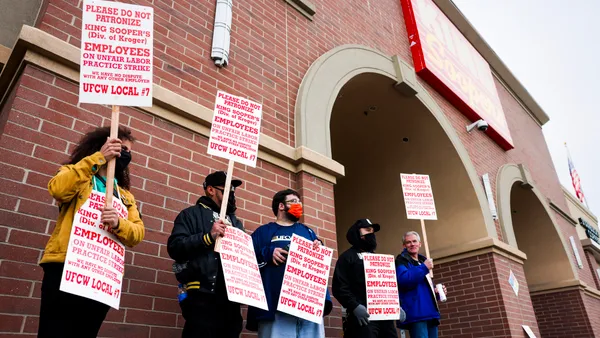LAS VEGAS — Kroger does not want history to repeat itself with its latest store divestiture plan.
When the grocer was whittling down the list of possible buyers for the stores it intends to sell to win approval to merge with Albertsons, the company made the point of trying to avoid repeating the scenario in which Albertsons repurchased divested locations when it combined with Safeway in 2015, Kroger Chairman and CEO Rodney McMullen said Tuesday at Groceryshop.
Kroger examined the factors that led to the undoing of Albertsons’ ill-fated divestiture arrangement with Haggen and ultimately decided to sell hundreds of stores and other assets to C&S Wholesale Grocers because it believes C&S is strong enough to be a viable competitor, McMullen said during a keynote session at the conference.
“One of the things that we did was study the prior case in terms of what was criticized and why,” McMullen said. “It was really important to find somebody that had a strong balance sheet, had operated in the business and understood the grocery business and had scale, had talent, understood what they had and didn’t have.”
Another reason C&S emerged as the top choice was that the company was willing to honor labor contracts covering workers whose stores are slated for sale, McMullen said, adding that Kroger evaluated “dozens of potential buyers” — some of which were non-unionized — before selecting C&S.
McMullen said Kroger is eager to conclude its merger with Albertsons as soon as possible. “Once you decide to do something and once you come to [an] agreement, everything is urgent then, because you really do want to get the two companies merged so you can start doing the things that are good for communities, good for associates and good for customers,” he said.
While a key reason Kroger is pressing to combine with Albertsons is that it wants to be able to spread costs for investments like data-processing technology and point-of-sale systems over a greater number of stores, the company is intent on providing the feel of a small grocer to shoppers even as it gets bigger, McMullen said.
“Most of our customers shop one, two or three of our stores at most. And [it's incumbent on Kroger] for a customer to feel like it’s only their store,” said McMullen.
He continued: “We feel like we’ve really done an awesome job when a customer says, ‘Well that’s my Ralphs’ or ‘That’s my Food 4 Less’ or ‘That’s my Fred Meyer,’ because then you know that we’ve been able to balance that on providing the economies of scale … but at the same time doing things where that customer knows that those associates in that store are taking care of them.”
McMullen also said during the keynote that Kroger’s top priority is ensuring that it is able to serve customers no matter the shopping method they choose, noting the company is looking to operations like retail media to help defray e-commerce costs.
“Job one is don’t lose that customer. Job two is we have to figure out a way to have the same profitability of that customer that shops online when we’re picking their products versus them picking it themselves and we have to deliver it to their house,” McMullen said.
McMullen added Kroger has come to rely on its fee-based Boost membership program to help maintain ties with shoppers. That program, announced in late 2021, provides participants with free delivery and extra fuel points and accounts for “well over half” of Kroger’s delivery business, he said.
“It’s not necessarily the income that you make off of it but the stickiness of it,” said McMullen. “When you become top of mind, you’re able to gain share … it’s just part of that overall equation. Our aspiration is for people to fall in love with the experience, fall in love with our associates and then just give an incredible value.”













